Determining the severity of pugging damage
You need to assess the damaged paddocks and then categorise them by pugging severity so you can plan what treatments to carry out.
How much area of the farm has been damaged by pugging?
Recovery will vary depending on the severity and scale of the pugging damage. Farms in extremely wet areas, or with large damaged areas, will take longer to recover, cost more and create more stress.
Think about the effect on rotation length and availability of milker quality feed in summer or autumn when paddocks have been taken out of the rotation for a summer crop or autumn renovation. Normally this is 5 to 10 per cent of the farm but can be 20 per cent to over 50 per cent (or higher) on farms with severe pugging damage. This has huge implications for feeding your herd over the next 15 to 18 months.
If large sections of the farm are affected, you will need to consider:
- When can you start the rejuvenation process?
- How will you rejuvenate the affected areas?
- Will it need to be totally renovated (plough, power harrow or roterra) or possibly oversown to get you out of trouble till next autumn and then carrying out further renovation?
- What species in what areas will be sown now versus later sowings for those needing warmer soils?
What is the severity of pugging in individual paddocks?
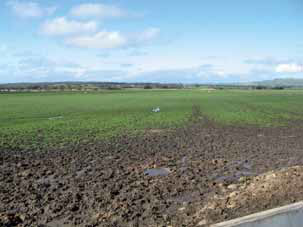
If the damage in each paddock has only occurred in specific areas (Figures 1 and 2), consider repairing this area only. Separate the remainder of the paddock using temporary electric fencing. One option is to cut the non-pugged section for silage or hay whilst allowing the pugged part to recover.

Examine the density of the pasture. Many bare areas will fill in from ryegrass tillering but if bare ground is 40 to 50 per cent then you should increase plant numbers.
Puggology — determining the severity of pugging
Estimating pugging severity can be difficult — it can look worse in muddy, windy and rainy conditions and sometimes better in finer, warmer and drier conditions. There is also the question of which paddocks need your attention. One paddock may be 25 per cent affected with very deep pugging while another may be 75 per cent affected with very shallow pugging. Which one should you focus on? Would you try to repair the 25 per cent deeply pugged paddock?
To help determine the severity of damage to individual paddocks or areas within paddocks, a simple tool, Puggology, has been developed. Using the Puggology chart and instructions you can categorise the severity of pugging damage and clarify the action needed.
Puggology chart
(Area × Depth Matrix)
0 to 25 per cent area of paddock pugged:

25 to 50 per cent area of paddock pugged:

50 to 75 per cent area of paddock pugged:

Less than 100 per cent area of paddock pugged:

100 per cent area of paddock pugged:

Table 1 showing area of paddock pugged and depth of pugging
| Depth of pugging | >1 (0-25%) | 2 (25-50%) | 3 (50-75%) | 4 (less than 100%) | 5 (100%) |
|---|---|---|---|---|---|
Shallow (0-2cm) | 0 to Very light | Very light | Very light | Severe | Light |
Medium (2-5cm) | Very light | Light | Medium | Very severe | Very severe |
Deep (5-8cm) | Very light to light | Medium | Very severe | Very severe | Very severe |
Very deep (>8cm) | Light to middle | Severe | Very severe | Very severe | Very severe |
Assess pasture and soil damage within pugged areas
- Stand at ease.
- Place feet 1 metre apart.
- Now imagine a 1 metre square in front of your feet.
- Observe the following inside this 1 metre square.
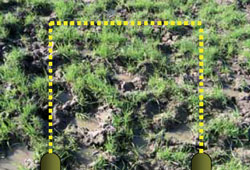
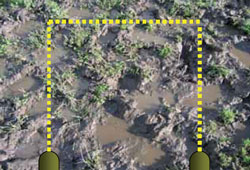
Consider:
- How much bare ground to grass is present? (Figures 3 and 4)
- How much grass is just covered with light dirt (possibly dust by now)?
- How much grass has been cleaned by follow up rains?
- How much grass is covered with mud and probably won't be washed off?
- Has any long grass been pressed into the mud itself (probably dead or dying)?
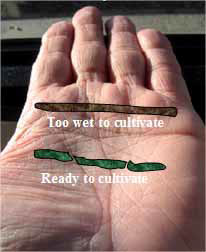
Look at the soil itself:
- Is it plastic? Do the worm test. Using your palm of one hand and fingers of the other roll about a tablespoon of soil into a worm of 4mm diameter and 5cm length.
- If it holds together the soil is probably still too moist and may smear if drilled, affecting seedling and root growth (Figure 5).
- Is it dry on top and wet underneath? (Unless rain or showers continue, germinating seed may have trouble, especially if the season cuts out.
- Is the soil damp but friable in the top 0 to 10cm? A clump of soil should break in the hand at the correct soil moisture level (ideal seedbed).
- How far have your feet sunk into the ground - still too wet?
Use the Puggology chart to categorise the damage within the paddock:
- What percentage area of the paddock is pugged?
- How deep are the pugging marks?
- Determine if the pugging damage is light, medium or severe.
Examples of Puggology scoring
Light pugging damage

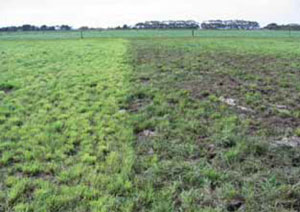
Medium pugging damage
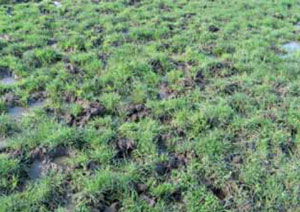
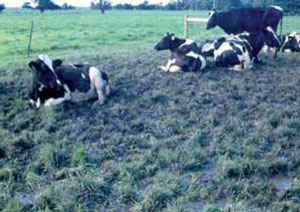
Severe pugging damage


Acknowledgements
This information was originally written by Frank Mickan, Ellinbank.
July 2011.